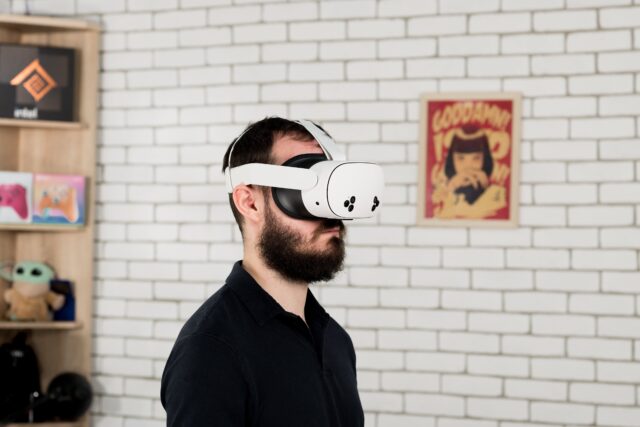Noise is everywhere – from bustling streets and crowded buses to buzzing cafes and open offices. As remote and hybrid work continue to rise, having a reliable noise-cancelling headset isn’t just a nice-to-have — it’s become essential. By 2025, it’s almost expected that a pair of headphones offers some form of noise control. But what does that really mean? In this guide, we’ll explain how different noise-cancelling technologies work, what to consider when choosing a headset, and where the tech is headed.
Why does noise cancellation matter so much today?
Whether you’re on a Zoom call, listening to music during your commute, or trying to concentrate in a noisy space, background noise is a daily challenge. A good noise-cancelling headset can help you:
- stay focused and productive,
- relax and unwind while traveling,
- enjoy clearer conversations during calls,
- and feel less drained at the end of the day.
Science backs this up: working in noisy environments reduces concentration and increases fatigue. No wonder noise cancellation is now high on the wish list for many users.
The two main types of noise cancellation
Passive noise cancellation – let the design do the work
This method relies on the physical construction of the headset to block out sound — no electronics involved. You’ll get the most from:
- snug silicone ear tips that seal the ear canal,
- cushioned over-ear designs that cover your ears completely,
- and closed-back headphone enclosures.
This approach is particularly good at reducing high-frequency sounds like voices, traffic, or keyboard clicks. A well-designed pair can lower outside noise by 15–20 dB.
Active noise cancellation (ANC) – tech to the rescue
ANC takes things further using advanced electronics. Here’s how it works:
- Built-in microphones pick up ambient noise in real time.
- The system creates an inverted soundwave — the opposite of the noise.
- The two waves cancel each other out, reducing what you hear.
ANC is especially good at neutralizing consistent, low-frequency sounds like:
- plane engine hums,
- train and bus rumbles,
- or air conditioning noise.
Some newer models even tackle mid and high-range sounds, though this remains trickier to perfect.
Understanding ANC variations
Feedforward ANC
Microphones are placed on the outside of the earbuds, capturing noise before it hits your ear. It reacts fast but can be thrown off by wind or sudden changes.
Feedback ANC
Here, microphones sit inside the ear cup and measure what you actually hear. It’s more accurate — especially for mid and higher frequencies.
Hybrid ANC
This combines both inside and outside mics to maximize coverage. It’s the most versatile and effective option, and you’ll find it in many premium models.
What is transparency mode?
Sometimes, blocking out the world isn’t ideal. Enter transparency mode, which does the opposite of ANC — it amplifies external sounds so you stay aware of your surroundings.It’s handy when:
- walking in busy areas,
- working in an office and need to hear colleagues,
- or exercising outside.
Some high-end headsets switch to this mode automatically when they detect speech around you.
Noise cancellation in microphones – so people hear you clearly
Headsets don’t just block sound for your ears — they also ensure your voice is clean and clear on calls. Common mic noise-cancelling tech includes:
- ENC (Environmental Noise Cancellation): filters background noise so your voice stands out.
- cVc (Clear Voice Capture): improves voice clarity and reduces distractions.
- Beamforming mics: focus on sound from your mouth and ignore the rest.
This makes a big difference in online meetings, phone calls, and gaming chats.
How well does ANC really work?
Effectiveness varies depending on:
- the ANC type (feedforward, feedback, hybrid),
- headset fit and seal,
- processor quality,
- and how noisy your environment is.
Top-tier models can cut noise by 25–35 dB. That’s enough to make loud spaces feel calm. But ANC can still struggle with sharp, unpredictable sounds like clanging dishes or barking dogs.
Buying guide: what to check before choosing a headset
- Your environment matters
- Frequent traveler? Prioritize ANC.
- Office or home user? Focus on comfort and mic quality.
- Sound quality expectations
- Look for support for high-end codecs like aptX, AAC, or LDAC.
- Frequent caller?
- Make sure the headset includes mic noise cancellation.
- Want to stay aware?
- Choose a model with transparency mode.
- Battery life checks
- ANC uses more power — always check battery life with ANC turned on.
- Try before you buy, if possible
- Everyone’s hearing is different. What works for others may not work for you.
What’s next for noise cancellation?
Tech keeps evolving, and 2025 is just the start. Expect to see:
- AI-based ANC that learns and adapts to your habits,
- automatic mode switching depending on environment,
- personalized hearing profiles,
- smarter voice isolation in calls.
The future isn’t about total silence — it’s about control. Hearing what you want, when you want it.Noise-cancelling headsets have gone from luxury to necessity. Whether for deep focus, better calls, or peaceful travel, they help cut through the clutter of daily life. As tech improves, they’re becoming even more intuitive and user-friendly.Before choosing one, think about your lifestyle, environment, and what matters most. And when possible — try them out.Tomorrow’s headsets won’t just block noise. They’ll adapt to you.
Image(s) used in this article are either AI-generated or sourced from royalty-free platforms like Pixabay or Pexels.
Did you enjoy this article? Buy me a coffee!





